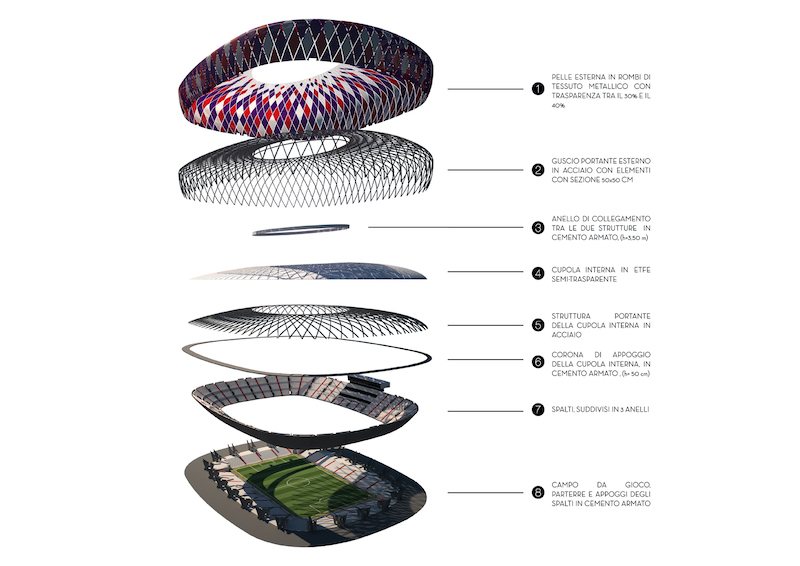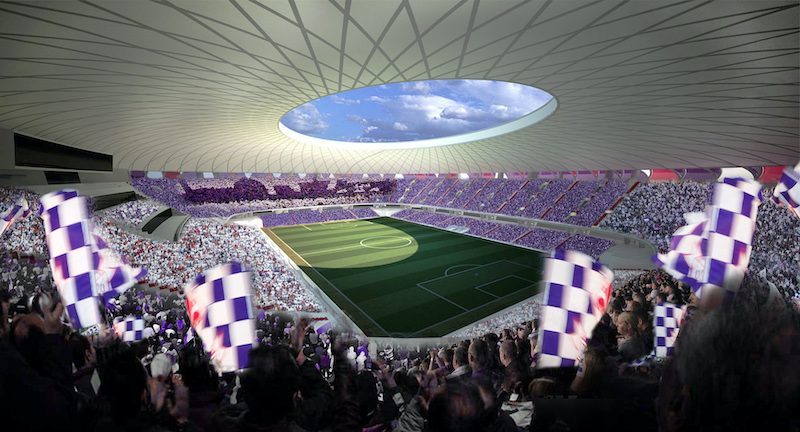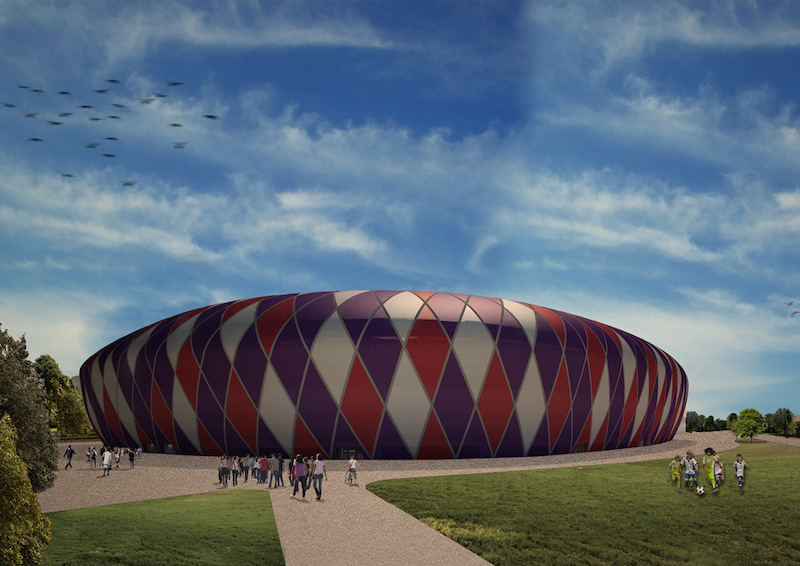Last June, Rocco Commisso, the Italian-American chairman of the cable TV provider Mediacom Communications, took ownership of the Italian soccer club A.C.F. Fiorentina, based in Florence, Italy, where the team is known locally as the Viola, for its violet-colored jerseys.
The 69-year-old Commisso, who also owns the New York Cosmos soccer club in the U.S., (and who previously tried, but failed, to acquire the A.C. Milan club in Italy) has identified the need for Fiorentina to play its home games in a modern sports stadium. Right now, the club plays at Stadio Artemio Franchi, which opened in 1931.
According to Stadium Business, the Municipality of Florence in October approved a proposal to make a plot of land available for the potential development of a new stadium.
Florence-based Pierattelli Architetture has proposed a design for that new stadium as a component of a master plan that upgrades and expands the Novoli district in the northwest part of the city. That master plan focuses on improving the area’s existing subpar road network, and creating a new road network through the city’s food and beverage market known as Mercafir.
Pierattelli envisions a rhomboid-shaped stadium that resembles a large stone, higher on one side than the other, whose outer structure is clad in metal mesh of purple, white, and red, the team’s colors. The building would have 16 entrance points (four with turnstiles), and three grandstand rings, as well as a shopping mall and food service.
The 40,000-seat stadium would have a perimeter of approximately 600 meters (1,969 feet), a maximum width of over 200 meters, and a maximum length of 150 meters. Its height would range from 30 to 40 meters, with the highest section overlooking the grandstands in front of the new entrance.
The building is designed as a series of rings. A double-volume ring at the ground floor level channels the flow of people into different areas and levels. The second ring includes VIP grandstands, and 10 skyboxes of about 172 sf each and four of which would include meeting rooms. The last ring, which dominates the stadium, would house the dividers and columns that support the building’s entire internal structure.
There would also be an underground area for a swimming pool, dressing rooms, warm-up area and wellness center, and hospitality suite through which the press room, VIP grandstands and restrooms could be accessed.

Pierattelli's stadium design revolves around a series of architectural rings.
Pierattelli has positioned its design proposal as “a new vision of the city,” that amalgamates architecture, urban planning, and social life. The 148-acre Novoli neighborhood is currently lacking modern infrastructure. Pierattelli proposes that Viale Guidone, the city’s main traffic artery, be redirected as a one-way thoroughfare underground through a tunnel whose entrance would be near the city’s railway and whose exit would be in front of the city’s Palace of Justice. Ground-level pedestrian and cycle paths would be maintained.
Another road would be added that connects the city’s Piazza Artom with its Via dell’Olmatello, and divides the Mercafir in half, making part of this road exclusively for foot traffic, and “an island of peace within an area of inter-municipal traffic,” states the architect. The Municipality of Florence has opted to put part of the Mercafir area up for sale, with a prospect of that land being purchased for the development of the new stadium, according to Stadium Business.
The master plan also proposes creating four artificial hills with a maximum height of six meters, which would establish the neighborhood’s boundaries and provide more green space for the city.
Commisso has stated his goal to move his team into a new stadium by September 2023. The question remains, though, whether the team will be receptive to the municipality’s redevelopment plan. The club reportedly is weighing leaving this area of Florence to develop its new stadium in the commune of Campi Besenzio, about 10 miles northwest of Florence.

The proposed stadium would seat 40,000 fans. An underground floor would include a swimming pool and warm-up area for the contestants. Seen from above, the stadium resembles a flower.
Related Stories
| Nov 16, 2010
Brazil Olympics spurring green construction
Brazil's green building industry will expand in the coming years, spurred by construction of low-impact venues being built for the 2016 Olympics. The International Olympic Committee requires arenas built for the 2016 games in Rio de Janeiro meet international standards for low-carbon emissions and energy efficiency. This has boosted local interest in developing real estate with lower environmental impact than existing buildings. The timing couldn’t be better: the Brazilian government is just beginning its long-term infrastructure expansion program.
| Nov 3, 2010
Park’s green education center a lesson in sustainability
The new Cantigny Outdoor Education Center, located within the 500-acre Cantigny Park in Wheaton, Ill., earned LEED Silver. Designed by DLA Architects, the 3,100-sf multipurpose center will serve patrons of the park’s golf courses, museums, and display garden, one of the largest such gardens in the Midwest.
| Nov 3, 2010
Sailing center sets course for energy efficiency, sustainability
The Milwaukee (Wis.) Community Sailing Center’s new facility on Lake Michigan counts a geothermal heating and cooling system among its sustainable features. The facility was designed for the nonprofit instructional sailing organization with energy efficiency and low operating costs in mind.
| Nov 3, 2010
Recreation center targets student health, earns LEED Platinum
Not only is the student recreation center at the University of Arizona, Tucson, the hub of student life but its new 54,000-sf addition is also super-green, having recently attained LEED Platinum certification.
| Oct 13, 2010
New health center to focus on education and awareness
Construction is getting pumped up at the new Anschutz Health and Wellness Center at the University of Colorado, Denver. The four-story, 94,000-sf building will focus on healthy lifestyles and disease prevention.
| Oct 13, 2010
Community center under way in NYC seeks LEED Platinum
A curving, 550-foot-long glass arcade dubbed the “Wall of Light” is the standout architectural and sustainable feature of the Battery Park City Community Center, a 60,000-sf complex located in a two-tower residential Lower Manhattan complex. Hanrahan Meyers Architects designed the glass arcade to act as a passive energy system, bringing natural light into all interior spaces.
| Oct 13, 2010
Community college plans new campus building
Construction is moving along on Hudson County Community College’s North Hudson Campus Center in Union City, N.J. The seven-story, 92,000-sf building will be the first higher education facility in the city.
| Oct 12, 2010
Owen Hall, Michigan State University, East Lansing, Mich.
27th Annual Reconstruction Awards—Silver Award. Officials at Michigan State University’s East Lansing Campus were concerned that Owen Hall, a mid-20th-century residence facility, was no longer attracting much interest from its target audience, graduate and international students.
| Oct 12, 2010
Building 13 Naval Station, Great Lakes, Ill.
27th Annual Reconstruction Awards—Gold Award. Designed by Chicago architect Jarvis Hunt and constructed in 1903, Building 13 is one of 39 structures within the Great Lakes Historic District at Naval Station Great Lakes, Ill.
| Sep 16, 2010
Green recreation/wellness center targets physical, environmental health
The 151,000-sf recreation and wellness center at California State University’s Sacramento campus, called the WELL (for “wellness, education, leisure, lifestyle”), has a fitness center, café, indoor track, gymnasium, racquetball courts, educational and counseling space, the largest rock climbing wall in the CSU system.
















